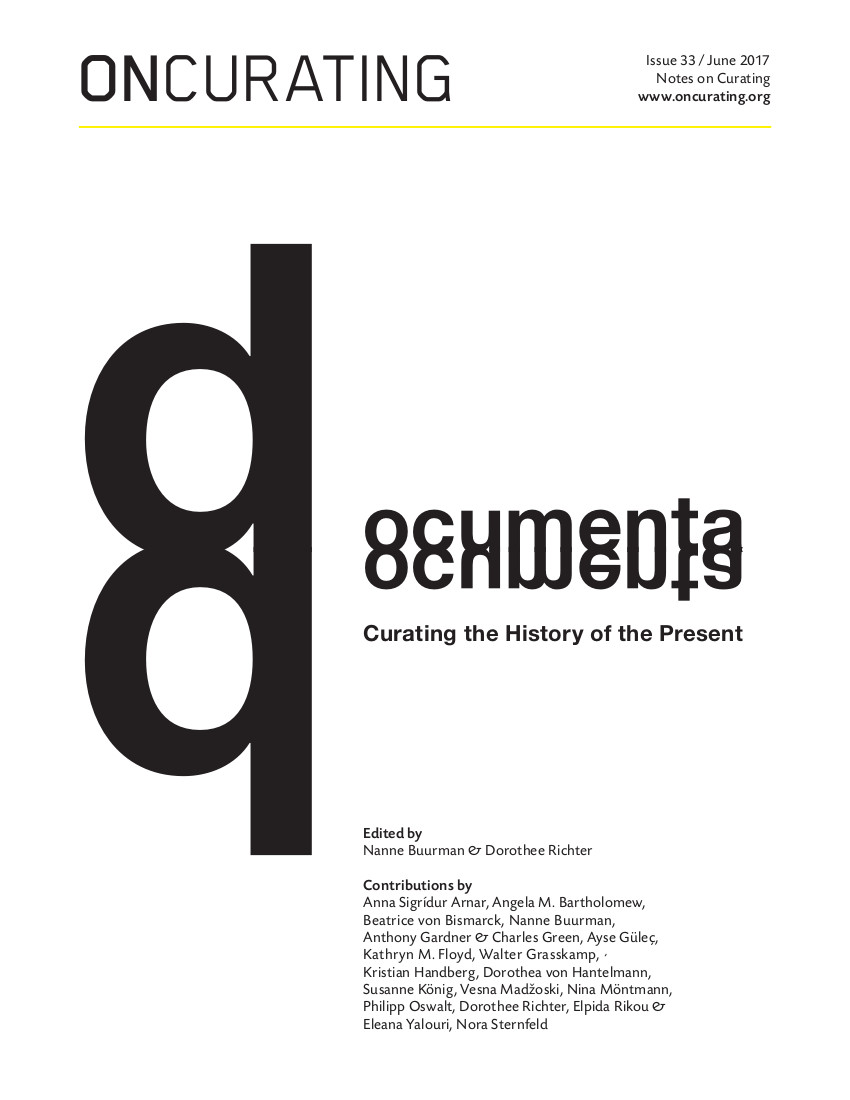OnCurating, 33: documenta. Curating the History of the Present (2017)
Filed under journal | Tags: · art, art history, contemporary art, curating, exhibition

“On the occasion of documenta’s 14th edition, this special issue scrutinizes the ways in which the Kassel-based periodic exhibition has been contributing to curating the history of the present since its inception in 1955. The authors engage with questions of how documenta’s iterations played a significant role not only in the making of a history of contemporary art but also in the canon of the relatively young field of curatorial and exhibition studies.”
Contributions by Anna Sigrídur Arnar, Angela M. Bartholomew, Beatrice von Bismarck, Nanne Buurman, Anthony Gardner & Charles Green, Ayse Güleç, Kathryn M. Floyd, Walter Grasskamp, Kristian Handberg, Dorothea von Hantelmann, Susanne König, Vesna Madžoski, Nina Möntmann, Philipp Oswalt, Dorothee Richter, Elpida Rikou & Eleana Yalouri, Nora Sternfeld.
Edited by Nanne Burmann and Dorothee Richter
Publisher OnCurating.org, Zürich, June 2017
Open access
171 pages
Elena Filipovic: The Apparently Marginal Activities of Marcel Duchamp (2013)
Filed under thesis | Tags: · archive, art, art history, curating, museum, photography, reproduction
“This study focuses on a series of fugitive operations that Marcel Duchamp incited in order to test, theorize, position, and even make his work as such. Not conventionally “artistic” in nature, even if intimately connected to the collection, presentation, reception, and valuation of art, these activities include Duchamp’s role as administrator, archivist, art advisor, curator, publicist, reproduction-maker, and salesman of his own oeuvre. Rather than merely procedural, auxiliary, or incidental, they might be thought of as constitutive, resulting in a still understudied but profoundly influential output by an artist who redefined so much of what, hence forth, would be called art. Here, those most iconic of Duchamp’s inventions, the readymades, although not the central objects of this study, are understood as significant insofar as they were not simply “nominated” to become artworks, but more importantly, because they were curated. It is precisely through curatorial operations—relative to much of Duchamp’s production, and constituting one of the central activities that this dissertation explores—that the artist rendered the discourse, institutions, marketing, and presentational strategies of art into something like his cardinal “medium.”
Tracing Duchamp’s perennial relationship to photography, reproduction, the museum, and the archive, and spanning the period between 1913 and 1969, three chapters closely examine a number of undeniably material things: chapter one considers the artist’s boxes of photographically replicated notes, the Box of 1914 (1913-14) and Boîte verte (1934); chapter two examines documentation of ephemeral exhibitions, recording Duchamp’s curatorial interventions as well as suitcases filled with miniature reproductions, the Boîte-en-valise (1938-42); and chapter three is dedicated to a permanent installation, Etant donnés 1. la chute d’eau, 2. le gaz d’éclairage (1946-66). However, the premise of this dissertation is that all of these gain a new significance if studied in relation to the elusive activities that actually constituted them as artworks. Together, they formed a counter-conception of the role of the artist, articulating—and complicating—the conceptual stakes of much of what is known of his practice and thickening into what Walter Benjamin called the artist’s “theory of the work of art.”” (Abstract)
Ph.D. Dissertation
Advisor: Hal Foster
Publisher Art and Archaeology Department, Princeton University, 2013
507 pages
PDF (2 MB)
PDF (images section) (10 MB)
WHW, tranzit.hu, Muzeum Sztuki w Łodzi, kuda.org (eds.): Art Always Has Its Consequences (2010)
Filed under book | Tags: · art, art history, curating, east-central europe, eastern europe, neo-avant-garde

“The publication is a result and a recapitulation a two-year collaborative platform that explored practices through which art reaches its audience and their significance for broader relations between art and society, focusing on four thematic strands: the history of exhibitions, artists’ texts, conceptual design, typography, and institutional archives. The book consists of three chapters; the first chapter contains of a chronology of the overall project events and exhibitions of the past two years. The second chapter is a reader of newly commissioned essays and reprints of relevant historical texts written or selected for the book around the issue of the former East. The third section is a documentation of the closing exhibition in Zagreb.”
Essays and interviews by G. M. Tamás, kuda.org & Hito Steyerl, Ovidiu Tichindeleanu, Renata Salecl, Boris Buden, Ozren Pupovac, Maciej Gdula, Gal Kirn, Hedwig Saxenhuber, Elena Filipovic.
Artist’s writings and documents from Miklós Erdély, Dóra Maurer, Goran Đorđević, Andreas Fogarasi, Guerilla Art Action Group, Tibor Hajas, Sanja Iveković, Andreja Kulunčić, David Maljković, Dimitrije Bašičević Mangelos, Vlado Martek, Piet Mondrian, Ciprian Mureşan, Deimantas Narkevičius, Novi Kolektivizam, Andrzej Partum, Gyula Pauer, Tamás St.Auby, Tomo Savić – Gecan, Sean Snyder, Mladen Stilinović, Bálint Szombathy, Milan Trenc, Ultra-red, GEFF, Radoslav Putar, and Symposium Wroclaw ’70.
Edited by What, How & for Whom/WHW [Ivet Ćurlin, Ana Dević, Nataša Ilić, Sabina Sabolović], Dóra Hegyi & Zsuzsa László [tranzit.hu], Magdalena Ziółkowska & Katarzyna Słoboda [Muzeum Sztuki w Łodzi], and new media center_kuda.org
Publisher What, How & for Whom/WHW, Zagreb, 2010
ISBN 9535595113, 9789535595113
265 pages
via WHW

